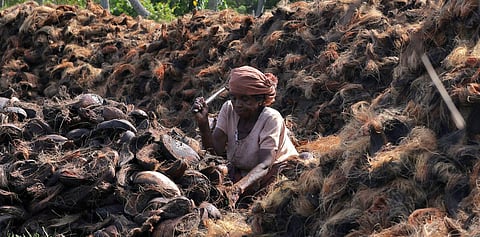

THIRUVANANTHAPURAM: Kerala is the mainstay of India’s coir industry, accounting for 61 per cent of production and 85 per cent of products. It is the largest cottage industry, employing over a million people. However, the introduction of synthetic fibres and negligence on the part of authorities brought an abrupt end to the industry’s heydays. Now, many traditional coir manufacturers face a bleak future.
Nowhere is this fact more profound than in Perunguzhi, a quaint hamlet in Chirayinkeezhu, once a hub of coir manufacturing in the state. Where once toiled over 500 workers, only a handful remain — they are the few who took to the industry during their childhood and still cling to it with rose-tinted lenses.
Most stay away because the daily wages have shrunk. Now, after a day’s breaking work, many manage to make only between Rs 300-450. Even then, some have not received their wages for the past eight months.
The process
The coir is extracted from coconut husks. The first step is to ret the husk in salt water and then cover it with mud to stimulate the decaying process. This helps to separate the fibre threads easily. After nine months, the husks are removed from the retting mound, loaded into canoes and then taken to the threshing compounds. They are then pounded with mallets or machetes. After this, the fibres are pulled and taken to the nearby spinning sheds.